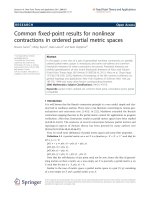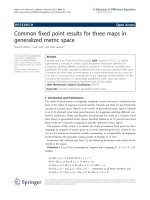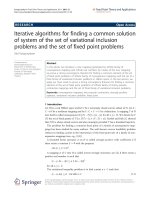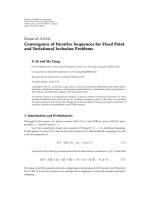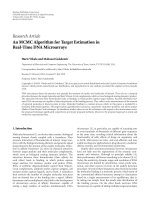Inertial proximal point algorithm for variational inclusion in hadamard manifolds
Bạn đang xem bản rút gọn của tài liệu. Xem và tải ngay bản đầy đủ của tài liệu tại đây (1.2 MB, 13 trang )
Applicable Analysis
An International Journal
ISSN: (Print) (Online) Journal homepage: />
Inertial proximal point algorithm for variational
inclusion in Hadamard manifolds
Shih-Sen Chang, Jen-Chih Yao, M. Liu & L. C. Zhao
To cite this article: Shih-Sen Chang, Jen-Chih Yao, M. Liu & L. C. Zhao (2021): Inertial proximal
point algorithm for variational inclusion in Hadamard manifolds, Applicable Analysis, DOI:
10.1080/00036811.2021.2016719
To link to this article: />
Published online: 16 Dec 2021.
Submit your article to this journal
Article views: 43
View related articles
View Crossmark data
Full Terms & Conditions of access and use can be found at
/>
APPLICABLE ANALYSIS
/>
Inertial proximal point algorithm for variational inclusion in
Hadamard manifolds
Shih-Sen Changa , Jen-Chih Yaoa , M. Liub and L. C. Zhaob
a Center for General Education, China Medical University, Taichung Taiwan; b Department of Mathematics, Yibin
University, Yibin, People’s Republic of China
ABSTRACT
ARTICLE HISTORY
In this paper, we consider the inertial proximal point algorithm for finding
a zero point of variational inclusions on Hadamard manifolds. Under suitable conditions, it is proved that the sequence generated by the algorithm
converges to an element of the set of zero points of variational inclusion
problem. As applications, we utilize our results to study the minimization
problem and saddle point problem in the setting of Hadamard manifolds.
Received 21 September 2021
Accepted 17 November 2021
COMMUNICATED BY
B. Mordukhovich
KEYWORDS
Monotone inclusion
problem; Hadamard
manifold; regularization
method; inertial proximal
point algorithm; Fejér
monotone
SUBJCLASS (2010)
49J53; 58E35; 47J22; 58C30
1. Introduction
During the past two decades, many authors have drawn their attention to the following variational
inclusion problem of finding x∗ ∈ X such that
0 ∈ (A + B)(x∗ ),
(1)
where X is a real Banach space, A : X → X is an operator and B : X → 2X is a set-valued operator.
This problem includes, as special cases, convex programming, variational inequalities, split feasibility problem and minimization problem. To be more precise, some concrete problems in machine
learning, image processing and linear inverse problem can be modeled mathematically as the form
of (1).
For solving the problem (1), the forward-backward splitting method (see, for example, [1–3]) is
usually employed and defined by the following manner: x1 ∈ H and
xn+1 = (I + rB)−1 (xn − rAxn ),
n ≥ 1,
(2)
where r > 0. This method includes, as special cases, the proximal point algorithm [4] and the gradient
method.
In recent years, the forward-backward splitting method has been extended by many authors.
In Ref. [5], Alvarez and Attouch employed the heavy ball method which was studied in Ref. [6] for
maximal monotone operators by the proximal point algorithm. This algorithm is called the inertial
CONTACT Shih-sen Chang
© 2021 Informa UK Limited, trading as Taylor & Francis Group
2
SHIH-SEN CHANG ET AL.
proximal point algorithm and it is of the following form:
yn = xn + θn (xn − xn−1 )
xn+1 = (I + rn B)−1 yn ,
n ≥ 1.
(3)
It was proved in Ref. [5] that if {rn } is non-decreasing and {θn } ⊂ [0, 1) with
∞
θn ||xn − xn−1 ||2 < ∞,
(4)
n=1
then algorithm (3) converges weakly to a solution of the following inclusion problem
0 ∈ B(x).
(5)
Here, θn is an extrapolation factor and the inertia is represented by the term θn (xn − xn−1 ). It is
remarkable that the inertial methodology greatly improves the performance of the algorithm and has
a nice convergence properties.
In Ref. [7], Moudafi and Oliny proposed the following inertial proximal point algorithm for solving
problem (1) in Hilbert space H:
yn = xn + θn (xn − xn−1 )
xn+1 = (I + rn B)−1 (yn − rn Axn ), n ≥ 1.
(6)
where A : H → H and B : H → 2H . They obtained the weak convergence theorem provided rn <
2/L with L the Lipschitz constant of A and the condition (4) holds.
In Ref. [1], Lorenz and Pock proposed the following inertial forward-backward algorithm for
monotone operators:
yn = xn + θn (xn − xn−1 )
xn+1 = (I + rn B)−1 (yn − rn Ayn ), n ≥ 1.
(7)
where {rn } is a positive real sequence. It is observed that algorithm (7) differs from that of Moudafi
and Oliny insofar that they evaluated the operator B as the inertial extrapolate {yn }.
Recently, Li et al. [8] considered the inclusion problem (5) in the setting of Hadamard manifold M.
They extended the proximal point algorithm from Hilbert spaces to Hadamard manifolds as follows:
0 ∈ λn B(xn+1 ) − exp−1
xn+1 xn ,
n ≥ 0,
(8)
where exp is the exponential mapping. Later on, Tang and Huang [9] extended the inexact proximal
point algorithm in the framework of Hadamard manifold M as
en+1 ∈ λn B(xn+1 ) − exp−1
xn+1 xn ,
n ≥ 0.
(9)
where {en }n≥1 can be regarded as an error sequence which satisfies some appropriate conditions with
||en+1 || ≤ σn d(xn+1 , xn ) and n≥0 σn2 < +∞, where d is the Riemannian metric on M. They studied strong convergence of the sequence generated by algorithm (9) to a solution of the inclusion
problem (5).
Very recently, Al-Homidan-Ansari-Babu [10], Ansari et al. [11–14], Chang et al. [15–17], Liu et al.
[18] and Zhu et al. [19] considered the variational inclusion problem (1) in a Hadamard manifold,
where B is a set-valued maximal monotone vector field, and A is a single-valued continuous and
monotone vector field. They proposed some Halpern-type and Mann-type iterative methods. Under
suitable conditions, they proved that the sequence generated by the algorithm converges strongly to
a element of the set of solutions of variational inclusion problem (1).
APPLICABLE ANALYSIS
3
Motivated by the works of Alvarez et al. [5], Tang and Huang [9], Li [8], Ansari et al. [11–14],
Al-Homidan et al. [10], Chang et al. [15–17], and the research ongoing in this direction, the purpose
of this article is to propose the following inertial proximal point algorithm for solving variational
inclusion problem (1) in Hadamard manifold M:
−1
− αn Pxn+1 ,xn exp−1
xn xn−1 ∈ λn (A + B)(xn+1 ) − expxn+1 xn ,
n≥1
(10)
where Py,x : Tx M → Ty M is the parallel transport on the tangent bundle TM along a minimal
geodesic joining x to y (the definition see Section 2). Under suitable conditions, it is proved that
the sequence {xn } generated by the algorithm (10) converges to an element of the set of solutions of
variational inclusion problem (1) in Hadamard manifold M. As applications, we utilize our results to
study the minimization problems and saddle point problems in the setting of Hadamard manifolds.
2. Preliminaries
In this section, we recall some notations, terminologies and basic results from Riemannian manifold
which can be found in any textbook on Riemannian geometry (see, for example [20]).
Let M be a finite-dimensional differentiable manifold, Tp M be the tangent space of M at p ∈ M.
We denote by TM = p∈M Tp M the tangent bundle of M. An inner product ·, · p on Tp M is called
a Riemannian metric on Tp M. A tensor field ·, · is said to be a Riemannian metric on M if for
every p ∈ M, the tensor ·, · p is a Riemannian metric on Tp M. The corresponding norm to the inner
product ·, · p on Tp M is denoted by || · ||p . We omit the subscript p, if there is no confusion occurs.
A differentiable manifold M endowed with a Riemannian metric ·, · is called a Riemannian
manifold. The length of a piecewise smooth curve γ : [0, 1] → M joining p to q (i.e. γ (0) = p and
γ (1) = q) is defined as
L(γ ) =
1
0
||γ (t)|| dt.
(11)
The Riemannian distance d(p, q) is the minimal length over the set of all such curves joining p to q,
which induces the original topology on M.
Let ∇ be the Levi-Civita connection associated with the Riemannian metric. Let γ be a smooth
curve in M. A vector field X along γ is said to be parallel if ∇γ X = 0, where 0 is the zero tangent
vector. If γ itself is parallel along γ , we say that γ is a geodesic, and in this case ||γ || is constant.
When ||γ || = 1, γ is said to be normalized. A geodesic joining x to y in M is said to be minimal if
its length equals d(x, y).
A Riemannian manifold M is complete if for any p ∈ M, all geodesics emanating from p are defined
for all t ∈ R. A geodesic joining p to q in M is said to be a minimal geodesic if its length is equal to
d(p, q). A Riemannian manifold M equipped with Riemannian distance d is a metric space (M, d). By
Hopf-Rinow Theorem [20], if M is complete then any pair of points in M can be joined by a minimal
geodesic. Moreover, (M, d) is a complete metric space and bounded closed subsets are compact.
If M is a complete Riemannian manifold, then the exponential map expp : Tp M → M at p ∈ M
is defined by expp v = γv (1, p) for all v ∈ Tp M, where γv (·, p) is the geodesic starting from p with
velocity v, that is, γv (0, p) = p and γv (0, p) = v.
It is known that expp tv = γv (t, p) for each real number t. It is easy to see that expp 0 = γv (0, p) =
p, where 0 is the zero tangent vector. Note that the exponential map expp is differentiable on Tp M for
any p ∈ M.
The parallel transport Pγ ,γ (b),γ (a) : Tγ (a) M → Tγ (b) M on the tangent bundle TM along γ :
[a, b] → R with respect to ∇ is defined by:
Pγ ,γ (b),γ (a) (v) = V(γ (b)),
∀a, b ∈ R and v ∈ Tγ (a) M,
where V is the unique vector field such that ∇γ (t) V = 0 for all t ∈ [a, b] and V(γ (a)) = v. If γ is
a minimal geodesic joining x to y, then we write Py,x instead of Pγ ,y,x . Note that, Py,x is an isometry
4
SHIH-SEN CHANG ET AL.
from Tx M to Ty M. That is, the parallel transport preserve the inner product
Py,x (u), Py,x (v)
y
= u, v x ,
∀u, v ∈ Tx M.
Moreover, from Li et al. [8], we have the following result:
Lemma 2.1: If x, y, z ∈ M, then
−1
(i) Px,y exp−1
y x = − expx y, and ||Py,x u|| = ||u|| for all u ∈ Tx M;
(ii) (see, [8, P. 671], see also, [21, Remark 2.1]) if v ∈ Ty M, then
−1
−1
v, − exp−1
y x = v, Py,x expx y = Px,y v, expx y .
Definition 2.2: A complete simply connected Riemannian manifold of non-positive sectional curvature is called a Hadamard manifold.
Proposition 2.3 ([20]): Let M be a Hadamard manifold and p ∈ M. Then expp : Tp M → M is a diffeomorphism, and for any two points p, q ∈ M, there exists, a unique normalized geodesic γ : [0, 1] →
M joining p = γ (0) to q = γ (1) which is in fact a minimal geodesic denoted by
γ (t) = expx t exp−1
x y,
∀t ∈ [0, 1].
(12)
Rm .
Moreover, Hadamard
This proposition shows that M is diffeomorphic to the Euclidean space
manifolds and Euclidean spaces have some similar geometrical properties. One of the most important
properties is described in the following proposition.
Recall that a geodesic triangle (p1 , p2 , p3 ) in a Riemannian manifold M is a set consisting of three
points p1 , p2 and p3 , and three minimal geodesics γi joining pi to pi+1 , where i = 1, 2, 3(mod3).
Proposition 2.4 ([20]): Let (p1 , p2 , p3 ) be a geodesic triangle in a Hadamard manifold M. For each
i = 1, 2, 3(mod3), let γi : [0, li ] → M be the geodesic joining pi to pi+1 and αi be the angle between
tangent vectors γi (0) and −γi−1 (li−1 ). Then
(a) α1 + α2 + α3 ≤ π;
2 − 2l l
2
(b) li2 + li+1
i i+1 cosαi+1 ≤ li−1
As in Ref. [22], Proposition 2.4 (b) can be written in terms of Riemannian distance and exponential
mappings as:
−1
d2 (pi , pi+1 ) + d2 (pi+1 , pi+2 ) − d2 (pi−1 , pi ) ≤ 2 exp−1
pi+1 pi , exppi+1 pi+2 .
(13)
In the sequel, unless otherwise specified, we always assume that M is a finite-dimensional
Hadamard manifold, and C is a nonempty, bounded, closed and geodesic convex set in M and Fix(S)
is the fixed point set of a mapping S.
Definition 2.5: A function f : C → (−∞, ∞] is said to be geodesic convex if, for any geodesic
γ (λ)(0 ≤ λ ≤ 1) joining x, y ∈ C, the function f ◦ γ is convex, i.e.
f (γ (λ)) ≤ λf (γ (0)) + (1 − λ)f (γ (1)) = λf (x) + (1 − λ)f (y).
(14)
In the sequel, we denote by (M) the set of all single-valued vector fields A : M −→ TM such
that A(x) ∈ Tx M for each x ∈ M, and D(A) the domain of A defined by
D(A) = {x ∈ M : A(x) ∈ Tx M}.
Denote by X (M) the set of all set-valued vector fields B : M → TM such that B(x) ⊂ Tx M for all
x ∈ M, and D(B) the domain of B defined by D(B) = {x ∈ M : B(x) = ∅}.
APPLICABLE ANALYSIS
5
Definition 2.6 ([23]): A set-valued vector field A ∈ X (M) on a Hadamard manifold M is said to
be
(1) monotone if for any x, y ∈ D(A)
−1
u, exp−1
x y ≤ v, − expy x ,
∀u ∈ A(x) and ∀v ∈ A(y).
(2) maximal monotone if it is monotone and for all x ∈ D(A) and u ∈ Tx M, the condition
−1
u, exp−1
x y ≤ v, − expy x ,
∀y ∈ D(A) and ∀v ∈ A(y).
implies u ∈ A(x).
Li et al. [8] defined the upper Kuratowski semicontinuity for set-valued vector field in the setting
of Hadamard manifolds and gave its relation with the set-valued maximal monotone vector field.
Definition 2.7: A set-valued vector field A ∈ X (M) is said to be
(a) upper Kuratowski semicontinuous at x ∈ D(A) if for any sequences {xn } ⊂ D(A) and {un } ⊂
TM with each un ∈ A(xn ), the relations limn→∞ xn = x∗ and limn→∞ un = u∗ imply u∗ ∈
A(x∗ );
(b) upper Kuratowski semicontinuous on M if it is upper Kuratowski semicontinuous at each x ∈
D(A).
Lemma 2.8 (Theorem 3.7 of [10]): Suppose that A ∈ X (M) is monotone and D(A) = M. Then the
following statements are equivalent:
(i) the vector field A is maximal monotone;
(ii) the vector field A is upper Kuratowski semicontinuous on M, and A(x) is closed and convex for each
x ∈ M.
Definition 2.9: Let X be a complete metric space and Q ⊂ X be a nonempty set. A sequence {xn } ⊂ X
is called Fejér monotone with respect to Q if for any y ∈ Q and n ≥ 0,
d(xn+1 , y) ≤ d(xn , y).
Lemma 2.10 ([22, 24]): Let X be a complete metric space, Q ⊂ X be a nonempty set. If {xn } ⊂ X is
Fejér monotone with respect to Q, then {xn } is bounded. Moreover, if a cluster point x of {xn } belongs to
Q, then {xn } converges to x.
Lemma 2.11 ([25]): Let {ξn } ⊂ [0, 1) be a sequence. If
∞
n=1
ξn
< +∞,
1 − ξn
∞
n=1 ξn
∞
1+
and
n=1
< ∞, then
ξn
1 − ξn
< +∞.
3. Main results
We are now in a position to give the main result of this article.
Theorem 3.1: Let M be a finite-dimensional Hadamard manifold. Let B ∈ X (M) be a maximal monotone vector field with D(B) = M, and A ∈ (M) be a continuous single-valued vector fields with
6
SHIH-SEN CHANG ET AL.
A(x) ∈ Tx M for each x ∈ M such that (A + B) is a maximal monotone set-valued vector field with
D(A + B) = M. For any given x0 , x1 ∈ M let {xn } be the inertial proximal point sequence generated by
−1
− αn Pxn+1 ,xn exp−1
xn xn−1 ∈ λn (A + B)(xn+1 ) − expxn+1 xn ,
n≥1
(15)
where Pxn+1 ,xn : Txn M → Txn+1 M is the parallel transport on the tangent bundle TM along a minimal
geodesic γ joining xn to xn+1 , and the parameters αn and λn satisfy the following conditions:
(i) there exists λ > 0 such that λn ≥ λ, ∀n ≥ 1;
(ii) for each n ≥ 1, αn ≥ 0 and
||αn Pxn+1 ,xn exp−1
xn xn−1 || ≤ αn d(xn , xn+1 ) with
∞
αn2 < ∞.
(16)
n=1
If S := (A + B)−1 (0) = ∅, then there exists x∗ ∈ S such that {xn } converges strongly to x∗ as
n → ∞.
Proof: (I) We first examine the case where αn = 0, ∀n ≥ 1 which corresponds to the standard
proximal method. Although in this case, the result is well known, the proof gives some guidelines
for the general situation.
According to the assumptions of operators A and B, the mapping A + B ∈ X (M) is a maximal
monotone vector field with D(A + B) = M. Fix z ∈ S = (A + B)−1 (0) and define the auxiliary
real sequence
φn :=
1 2
d (xn , z),
2
n = 1, 2, . . . .
By (13) we have
−1
φn+1 ≤ φn + exp−1
xn+1 xn , expn+1 z −
Since αn = 0, from (15) we have
of A + B we deduce that
1
λn
1 2
d (xn .xn+1 ),
2
∀n ≥ 1.
(17)
exp−1
xn+1 xn ∈ (A + B)(xn+1 ). By virtue of the monotonicity
0 = 0, exp−1
z xn+1 ≤
1
−1
exp−1
xn+1 xn , − expxn+1 z
λn
−1
i.e. exp−1
xn+1 xn , expxn+1 z ≤ 0. Hence from (17) we have that φn+1 ≤ φn . Therefore we have
that
(1) d(xn+1 , z) ≤ d(xn , z), ∀n ≥ 1, i.e. {xn } is Fejér monotone with respect to S. By Lemma 2.10,
{xn } is bounded and for each z ∈ S, the limit limn→∞ d(xn , z) exists; and
2
2
(2) from (17), we have ∞
n=1 d (xn , xn+1 ) ≤ 2φ1 = d (x1 , z). This shows that
lim d(xn , xn+1 ) = lim || exp−1
xn+1 xn || = 0,
n→∞
n→∞
As λn is bounded away from zero we have
1
exp−1
xn+1 xn = 0.
n→∞ λn
lim
(18)
Since {xn } is bounded, by Hopf-Rinow Theorem [20], {xn } is a compact sequence. There exists a
subsequence {xnk } (for simplicity, we denote it by {xk }) of {xn } such that {xk } converges strongly
APPLICABLE ANALYSIS
7
to some point x∗ . Then from (18), we have
1
exp−1
xk+1 xk = 0.
k→∞ λk
(19)
lim
Since λ1k exp−1
xk+1 xk ∈ (A + B)(xk+1 ) and A + B is a maximal monotone vector field, by
Lemma 2.8, it is upper Kuratowski semicontinuous. Therefore, as xk → x∗ and combining (19),
we obtain 0 ∈ (A + B)(x∗ ), i.e. x∗ ∈ S. By Lemma 2.10, it follows that xn → x∗ .
This completes the proof of Theorem 3.1 when αn = 0, ∀n ≥ 1.
(II) Now we consider the case αn > 0 for some n ≥ 1.
From (15) we have
1
(exp−1
xn+1 xn + Vn+1 ) ∈ (A + B)(xn+1 ),
λn
∀ n ≥ 1,
(20)
where Vn+1 = −αn Pxn+1 ,xn exp−1
xn xn−1 . For any given z ∈ S, by using the monotonicity of A + B,
we have
1
−1
0 = 0, exp−1
exp−1
z xn+1 ≤
xn+1 xn + Vn+1 , − expxn+1 z .
λn
This implies that
−1
exp−1
xn+1 xn + Vn+1 , expxn+1 z ≤ 0.
(21)
−1
d2 (xn+1 , z) ≤ d2 (xn , z) − d2 (xn , xn+1 ) + 2 exp−1
xn+1 xn , expxn+1 z .
(22)
By (13), we have
This together with (21) shows
−1
d2 (xn+1 , z) ≤ d2 (xn , z) − d2 (xn , xn+1 ) + 2 exp−1
xn+1 xn , expxn+1 z
−1
= d2 (xn , z) − d2 (xn , xn+1 ) + 2 exp−1
xn+1 xn + Vn+1 , expxn+1 z
+ 2 Vn+1 , − exp−1
xn+1 z
≤ d2 (xn , z) − d2 (xn , xn+1 ) + 2 Vn+1 , − exp−1
xn+1 z .
(23)
Next we prove that {xn } is a bounded sequence and
lim d(xn , xn+1 ) = 0.
n→∞
(24)
In fact, since αn > 0, using the Cauchy-Schwarz inequality, we have
2 Vn+1 , − exp−1
xn+1 z ≤
1
2
||Vn+1 ||2 + 2αn2 || − exp−1
xn+1 z|| .
2αn2
This together with the condition (16) shows that
2 Vn+1 , − exp−1
xn+1 z ≤
1
d(xn , xn+1 ) + 2αn2 d2 (xn+1 , z).
2
Substituting (25) into (23), we have
d2 (xn+1 , z) ≤ d2 (xn , z) − (d2 (xn , xn+1 ) −
1 2
d (xn , xn+1 )) + 2αn2 d2 (xn+1 , z)
2
(25)
8
SHIH-SEN CHANG ET AL.
= d2 (xn , z) −
1 2
d (xn , xn+1 ) + 2αn2 d2 (xn+1 , z)
2
After simplifying, we have
(1 − 2αn2 ) d2 (xn+1 , z) ≤ d2 (xn , z) −
1 2
d (xn , xn+1 ).
2
(26)
Since αn → 0, there exists n0 ≥ 0 such that for all n ≥ n0 , 1 − 2αn2 > 0. Therefore, it follows from (26)
that
d2 (xn+1 , z) ≤
1
1
d2 (xn , z) −
d2 (xn , xn+1 )
1 − 2αn2
2(1 − 2αn2 )
≤ 1+
2αn2
1 − 2αn2
d2 (xn , z) −
1 2
d (xn , xn+1 ),
2
∀n ≥ n0 .
(27)
Thus we have
d2 (xn+1 , z) ≤ 1 +
Since
∞
2
n=1 αn
2αn2
1 − 2αn2
d2 (xn , z),
∀n ≥ n0 .
(28)
< ∞, it follows from Lemma 2.11 that
∞
n=n0
2αn2
< +∞,
1 − 2αn2
∞
1+
and
n=n0
2αn2
1 − 2αn2
< +∞.
2α 2
n
Since ∞
n=n0 1 + 1−2αn2 < +∞, this implies that {xn } is bounded.
On the other hand, from (27) we have that
1 2
2αn2
d2 (xn , z),
d (xn , xn+1 ) ≤ d2 (xn , z) − d2 (xn+1 , z) +
2
1 − 2αn2
∀n ≥ n0 ,
and thus
∞
∞
∞
2αn2
1
d2 (xn , xn+1 ) ≤
(d2 (xn , z) − d2 (xn+1 , z)) +
d2 (xn , z)
2
2 n=n
1
−
2α
n
n=n
n=n
0
0
0
∞
≤ d2 (xn0 , z) +
n=n0
2αn2
( sup d2 (xn , z)) < ∞.
1 − 2αn2 n≥n0
(29)
This implies that limn→∞ d(xn , xn+1 ) = 0. The conclusion (24) is proved. Therefore we have
−1
exp−1
xn+1 xn − αn Pxn+1 ,xn expxn xn−1 → 0 as n → ∞.
Since {xn } is bounded, by Hopf-Rinow Theorem [20], it is compact. There exists a subsequence
{xnj } ⊂ {xn } (for simplicity, we denote it by {xj }) such that xj → x∗ (some point in M). Since
−1
(exp−1
xj+1 xj − αj Pxj+1 ,xj expxj xj−1 ) ∈ (A + B)(xj+1 ) and A + B is upper Kuratowski semicontinuous.
This shows that 0 ∈ (A + B)(x∗ ), i.e. x∗ ∈ S.
Now we prove that S contains only a unique cluster point x∗ of {xn }.
APPLICABLE ANALYSIS
9
Suppose on the contrary, let x∗ and y∗ ∈ S be two cluster points of {xn }. Set
l1 = lim d2 (xn , x∗ );
n→∞
l2 = lim d2 (xn , y∗ ).
n→∞
(30)
Let {xnj } and {xnk } be two subsequences of {xn } such that limj→∞ xnj = x∗ and limk→∞ xnk = y∗ . By
inequality (13), we have
−1
∗
d2 (xnj , x∗ ) − d2 (xnj , y∗ ) ≤ d2 (x∗ , y∗ ) + 2 exp−1
y∗ x , − expy∗ xnj ;
(31)
−1
∗
d2 (xnk , y∗ ) − d2 (xnk , x∗ ) ≤ −d2 (x∗ , y∗ ) + 2 exp−1
y∗ x , expy∗ xnk ;
(32)
and
Taking j → ∞ in (31), it follows from (30) that
−1 ∗
∗
2 ∗ ∗
l1 − l2 ≤ d2 (x∗ , y∗ ) − 2 exp−1
y∗ x , expy∗ x = −d (x , y ).
(33)
Also taking k → ∞ in (32), from (30), we have
l2 − l1 ≤ −d2 (x∗ , y∗ ) + 0 = −d2 (x∗ , y∗ ).
(34)
These show that d2 (x∗ , y∗ ) ≤ l2 − l1 ≤ −d2 (x∗ , y∗ ). Therefore
l2 − l1 = d2 (x∗ , y∗ ) = 0,
i.e. x∗ = y∗ .
Hence S contains only a unique cluster point x∗ of {xn }. Therefore limn→∞ xn = x∗
This completes the proof of Theorem 3.1.
4. Applications
Throughout this section, we assume that M is a finite-dimensional Hadamard manifold and C is a
nonempty, bounded, closed and geodesic convex set in M.
4.1. Minimization problem on Hadamard manifolds
Let f : M → (−∞, +∞] be a differentiable function and g : M → (−∞, +∞] be a proper lower
semicontinuous and geodesic convex function. Consider the minimization problem: to find a point
x∗ ∈ M such that
(f + g)(x∗ ) = min(f + g)(x).
x∈M
(35)
We denote by the solution set of the minimization problem (35).
Let ∇f be the gradient of f and the subdifferential ∂g(x) of g at x ∈ M [23] is defined by
∂g(x) := {v ∈ Tx M : v, exp−1
x y ≤ g(y) − g(x), ∀y ∈ M}.
It is easy to check that ∂g(x) is closed and convex.
Lemma 4.1 ([26]): Let g : M → (−∞, +∞] be a proper lower semicontinuous and geodesic convex
function. Then, the subdifferential ∂f of f is a maximal monotone vector field. And
x∗ ∈
⇔ 0 ∈ ∂f (x∗ ).
From Theorem 3.1 and Lemma 4.1, we have the following result:
(36)
10
SHIH-SEN CHANG ET AL.
Theorem 4.2: Let f : M → (−∞, +∞] be a differentiable function with ∇f being continuous. Let
g : M → (−∞, +∞] be a proper lower semicontinuous and geodesic convex function with D(f ) = M.
Let ∂f be the subdifferential of f. For any given x0 , x1 ∈ M let {xn } be the inertial proximal point sequence
generated by
−1
− αn Pxn+1 ,xn exp−1
xn xn−1 ∈ λn (∇f + ∂g)(xn+1 ) − expxn+1 xn ,
n≥1
(37)
where the parameters αn and λn satisfy the conditions (i) and (ii) in Theorem 3.1. If the solution set
= ∅ of problem (35) and the condition (16) in Theorem 3.1 is satisfied, then there exists x∗ ∈ such
that {xn } converges strongly to x∗ .
Proof: In fact, under the conditions in Theorem 4.2, the mapping (∇f + ∂g) is a maximal monotone set-valued vector field with D(∇f + ∂g) = M. Therefore, the conclusion of Theorem 4.2 can be
obtained from Theorem 3.1 immediately.
4.2. Equilibrium problems on Hadamard manifolds
Let F : C × C → R be a bifunction satisfying the following conditions:
(A1) F(x, x) ≥ 0 for all x ∈ C;
(A2) F is monotone, that is, for any x, y ∈ C × C,
F(x, y) + F(y, x) ≤ 0;
(A3) For all x ∈ C, the function y → F(x, y) is geodesic convex and upper semicontinuous;
(A4) There exists a compact set D ⊂ M and a point z ∈ D C such that
F(x, z) < 0,
∀x ∈ C\D.
The equilibrium problem (in short, EP) is to find x∗ ∈ C such that
F(x∗ , y) ≥ 0,
∀y ∈ C.
(38)
The solution set of equilibrium problem (38) is denoted by EP(F).
Definition 4.3 (Colao et al. [27]): Let F : C × C → R be a bifunction. The resolvent RFλ : M ⇒ C
of F is a set-valued operator defined by
RFλ (x) = {z ∈ C : F(z, y) −
1
−1
exp−1
z x, expz y ≥ 0, ∀y ∈ C},
λ
∀x ∈ M.
(39)
Lemma 4.4 ([10]): Let C be a nonempty closed and gesdesic convex subset of a Hadamard manifold
M. Let F : C × C → R be a bifunction satisfying the conditions (A1)-(A4). Let HF : M ⇒ TM be a
set-valued mapping defined by
HF (x) :=
{v ∈ Tx M : F(x, y) ≥ v, exp−1
x y , ∀y ∈ C}, x ∈ C,
∅,
x ∈ C.
(40)
Then, EP(F) = HF−1 (0) and HF is maximal monotone with D(HF ) = M.
In Theorem 3.1, taking, A = 0 and B = HF , then the following result can be obtained from
Theorem 3.1 immediately.
APPLICABLE ANALYSIS
11
Theorem 4.5: Let F : C × C → R be a bifunction satisfying the conditions (A1) − (A4) and let HF :
M → M be the mapping defined by (40). For any given x0 , x1 ∈ M, let {xn } be the inertial proximal
point sequence generated by
−1
− αn Pxn+1 ,xn exp−1
xn xn−1 ∈ λn HF (xn+1 ) − expxn+1 xn ,
n≥1
(41)
where the parameters αn and λn satisfy the conditions (i) and (ii) in Theorem 3.1. If EP(F) = ∅, then
the sequence {xn } converges strongly to a solution of equilibrium problem (38).
5. Open question
It has been well recognized that the notion of weak sharp minima plays an important role in
both theoretical and numerical aspects of optimization. For the case of Riemannian and Hadamard
manifolds, weak sharp minima have been comprehensively investigated in the paper [28] Would it be
possible to use and/or develop some weak sharp consideration in the framework of our paper? The
corresponding discussions would be welcome.
Acknowledgements
The authors are grateful to the editor and the referees for their valuable comments and suggestions.
Disclosure statement
No potential conflict of interest was reported by the author(s).
Funding
This work was supported by the Natural Science Foundation of China Medical University, Taiwan; the Scientific
Research Fund of Sichuan Provincial Department of Science and Technology [grant number 2018JY0334]; the Scientific
Research Fund of SiChuan Provincial Education Department [grant number 14ZA0272].
References
[1] Lorenz D, Pock T. An inertial forward-backward algorithm for monotone inclusions. J Math Imaging Vis.
2015;51:311–325.
[2] Chang S-S, Yao J-C, Wang L, et al. On the inertial forward-backward splitting technique for solving a system of
inclusion problems in Hilbert spaces. Optimization. 2021;70:2511–2525.
[3] Tseng P. A modified forward-backward splitting method for maximal monotone mappings. SIAM J Control
Optim. 2000;38:431–446.
[4] Rockafellar RT. Monotone operators and the proximal point algorithm. SIAM J Control Optim. 1976;14(5):877–
898.
[5] Alvaezi F, Attouch H. An inertial proximal method for maximal monotone operators via discretization of a
nonlinear oscillator with damping. Set-Valued Anal. 2001;9:3–11.
[6] Polyak BT. Introduction to optimization. New York: Optimization Software, Publications Division; 1987.
[7] Moudafi A, Oliny M. Convergence of a splitting inertial proximal method for monotone operators. J Comput
Appl Math. 2003;155:447–454.
[8] Li C, López G, Martín-Márquez V. Monotone vector fields and the proximal point algorithm on Hadamard
manifolds. J Lond Math Soc. 2009;79(3):663–683.
[9] Tang GJ, Huang NJ. An inexact proximal point algorithm for maximal monotone vector fields on Hadamard
manifolds. Oper Res Lett. 2013;41:586–591.
[10] Al-Homidan S, Ansari QH, Babu F. Halpern- and mann-type algorithms for fixed points and inclusion problems
on hadamard manifolds. Numer Funct Anal Optim. 2019;40(6):621–653.
[11] Ansari QH, Babu F, Yao J-C. Regularization of proximal point algorithms in Hadamard manifolds. J Fixed Point
Theory Appl. 2019;21:189.
[12] Ansari QH, Babu F. Proximal point algorithm for inclusion problems in Hadamard manifolds with applications.
Optim Lett. 2021;15(3):901–921.
[13] Ansari QH, Babu F, Yao J-C. Inexact proximal point algorithms for inclusion problems on Hadamard manifolds.
J Nonlinear Convex Anal. 2020;21(10):2417–2432.
12
SHIH-SEN CHANG ET AL.
[14] Ansari QH, Babu F. Existence and boundedness of solutions to inclusion problems for maximal monotone vector
fields in Hadamard manifolds. Optim Lett. 2020;14(3):711–727.
[15] Chang S-S, Tang JF, Wen CF. A new algorithm for monotone inclusion problems and fixed points on Hadamard
manifolds with applications. Acta Math Sci. 2021;41(4):1250–1262.
[16] Chang S-S, Yao J-C, Yang L, et al. Convergence analysis for variational inclusion problems equilibrium problems
and fixed point in Hadamard manifolds. Numer Funct Anal Optim. 2021;42(5):567–582.
[17] Chang S-S, Yao JC, Liu M, et al. Shrinking projection algorithm for solving a finite family of quasi-variational
inclusion problems in Hadamard manifold. RACSAM. 2021;115:105.
[18] Liu M, Chang S-S, Zhu JH, et al. An iterative algorithm for finding a common solution of equilibrium problem, quasi-variational inclusion problem and fixed point on Hadamard manifolds. J Nonlinear Convex Anal.
2021;22(1):69–86.
[19] Zhu J, Tang J, Chang SS, et al. Common solution for a finite family of equilibrium problems, quasi-variational
inclusion problems and fixed points on Hadamard manifolds. Symmetry. 2021;13:1161.
[20] Sakai T. Riemannian geometry, translations of mathematical monographs. Providence (RI): American Mathematical Society; 1996.
[21] Chen JF, Liu SY, Chang XK. Modified Tseng’s extragradient methods for variational inequality on Hadamard
manifolds. Appl Anal. 2021;100(12):2627–2640.
[22] Ferreira OP, Oliveira PR. Proximal point algorithm on Riemannian manifolds. Optimization. 2002;51(2):257–270.
[23] López G, Martin-Marquez V, Wang F, et al. Forward-backward splitting methods for accretive operators in Banach
spaces. Abstr Appl Anal. 2012;2012:109236.
[24] Iusem AN. An iterative algorithm for the variational inequality problem. Comput Appl Math. 1994;13:103–114.
[25] Rudin W. Real and complex analysis. 3rd ed. New York: McGraw-Hill; 1987.
[26] Li C, Yao JC. Variational inequalities for set-valued vector fields on Riemannian manifolds: convexity of the
solution set and the proximal point algorithm. SIAM J Control Optim. 2012;50(4):2486–2514.
[27] Colao V, López G, Marino G, et al. Equilibrium problems in Hadamard manifolds. J Math Anal Appl.
2012;388(1):61–77.
[28] Li C, Mordukhovich BS, Wang J, et al. Weak sharp minima on Riemannian manifolds. SIAM J Optim.
2011;21(4):1523–1560.


